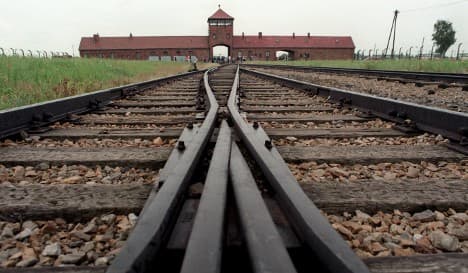Nazi camp photos on display in Warsaw

Haunting present-day photos of Nazi German death camp survivors from around the world went on display on Friday, in a Warsaw exhibition born out of a sense of urgency.
A Polish husband-and-wife team travelled to a dozen countries including Greece, Ukraine and the United States to interview and photograph former prisoners -- and not just Jews -- of various World War II camps.
The idea came to them in 2009 at Auschwitz-Birkenau, the most notorious of the camps, when they came across recent death notices for former inmates.
"We understood then that they're quickly passing away and that we belong to the last generation that can reach out to them, talk to them, find out more, understand better," said 33-year-old photographer Maciek Nabrdalik.
The month-long Irreversible exhibition features large black-and-white portraits in a narrow space, to force viewers to experience them face-to-face.
Nabrdalik said that for the current generation "the death camp era is as far removed as a trip to the moon, and we wanted them to get a closer understanding of it."
Several survivors whose images are part of the exhibition attended its Friday opening.
"I hope this exhibition will make the people of today reflect on what happened," said Jerzy Maria Ulatowski, who was deported to Auschwitz at 13 with his mother and little sister.
"These photos express all our fear, all we experienced, the living hell inside the camps," Danuta Bogdaniuk Bogacka, sent to Auschwitz at age 10 with her mother after the failed anti-Nazi 1944 Warsaw Uprising.
"Even after all these years, I have no idea how I managed to survive," the 79-year-old said, astonished by her portrait.
"The survivors are surprised by their own faces, by all the suffering that their portraits express," writer Agnieszka Nabrdalik told AFP.
Accompanying the 42 photos are recordings of young Poles reciting the prisoners' thoughts and memories. They speak of close calls with rape, post-war run-ins with guards and being fed human flesh.
Around a quarter of the profiled prisoners did not live to see the exhibition nor the release of the associated book, hammering home the project's urgency.
"One of the prisoners we were slated to meet died right before our visit," said Agnieszka, adding that they devoted an all-black photo to him.
The Nazis killed millions of people at wartime concentration camps including Jews, Poles, Roma, homosexuals and Soviet prisoners of war.
Comments
See Also
A Polish husband-and-wife team travelled to a dozen countries including Greece, Ukraine and the United States to interview and photograph former prisoners -- and not just Jews -- of various World War II camps.
The idea came to them in 2009 at Auschwitz-Birkenau, the most notorious of the camps, when they came across recent death notices for former inmates.
"We understood then that they're quickly passing away and that we belong to the last generation that can reach out to them, talk to them, find out more, understand better," said 33-year-old photographer Maciek Nabrdalik.
The month-long Irreversible exhibition features large black-and-white portraits in a narrow space, to force viewers to experience them face-to-face.
Nabrdalik said that for the current generation "the death camp era is as far removed as a trip to the moon, and we wanted them to get a closer understanding of it."
Several survivors whose images are part of the exhibition attended its Friday opening.
"I hope this exhibition will make the people of today reflect on what happened," said Jerzy Maria Ulatowski, who was deported to Auschwitz at 13 with his mother and little sister.
"These photos express all our fear, all we experienced, the living hell inside the camps," Danuta Bogdaniuk Bogacka, sent to Auschwitz at age 10 with her mother after the failed anti-Nazi 1944 Warsaw Uprising.
"Even after all these years, I have no idea how I managed to survive," the 79-year-old said, astonished by her portrait.
"The survivors are surprised by their own faces, by all the suffering that their portraits express," writer Agnieszka Nabrdalik told AFP.
Accompanying the 42 photos are recordings of young Poles reciting the prisoners' thoughts and memories. They speak of close calls with rape, post-war run-ins with guards and being fed human flesh.
Around a quarter of the profiled prisoners did not live to see the exhibition nor the release of the associated book, hammering home the project's urgency.
"One of the prisoners we were slated to meet died right before our visit," said Agnieszka, adding that they devoted an all-black photo to him.
The Nazis killed millions of people at wartime concentration camps including Jews, Poles, Roma, homosexuals and Soviet prisoners of war.
Join the conversation in our comments section below. Share your own views and experience and if you have a question or suggestion for our journalists then email us at [email protected].
Please keep comments civil, constructive and on topic – and make sure to read our terms of use before getting involved.
Please log in here to leave a comment.